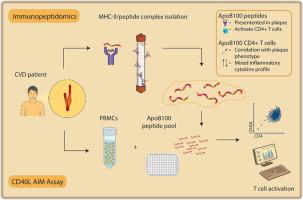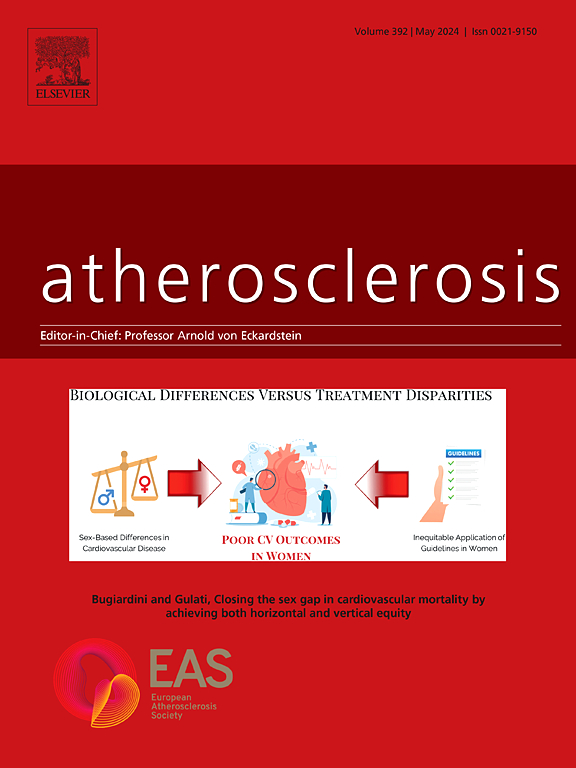人类动脉粥样硬化斑块的免疫肽组学分析确定动脉粥样硬化的抗原驱动因素
IF 5.7
2区 医学
Q1 CARDIAC & CARDIOVASCULAR SYSTEMS
引用次数: 0
摘要
背景和目的动脉粥样硬化具有由自身反应性T细胞和B细胞驱动的自身免疫成分。确定它们的抗原驱动因素可能会导致新的诊断和治疗方法。在这里,我们的目标是通过研究人类斑块中HLA呈递的肽库来鉴定来自动脉粥样硬化相关蛋白(如ApoB100)的免疫原性T细胞表位。方法应用免疫肽组学方法从接受动脉内膜切除术的患者斑块中鉴定HLA-DR分子所呈现的肽。我们选择了一组来自ApoB100的20多肽,研究了ApoB100特异性CD4+ T细胞在动脉粥样硬化患者外周血单个核细胞(PBMCs)中的存在和细胞因子谱。结果显示,22 - 39%的患者对这些ApoB100肽有明显的CD4+ T细胞活化反应,并且这种T细胞反应与斑块易感性呈正相关。这些细胞的特点是产生促炎性和抗炎性细胞因子。结论免疫肽组学是一种有效的动脉粥样硬化新抗原发现方法。本文章由计算机程序翻译,如有差异,请以英文原文为准。

Immunopeptidomics analysis of human atherosclerosis plaques identifies antigenic drivers of atherosclerosis
Background and aim
Atherosclerosis has an auto-immune component driven by self-reactive T and B cells. Identifying their antigenic drivers may lead to new diagnosis and treatment approaches. Here, we aim to identify immunogenic T cell epitopes derived from atherosclerosis-relevant proteins such as ApoB100 by studying the repertoire of peptides presented by HLA in human plaques.
Methods
We used immunopeptidomics to identify peptides presented by HLA-DR molecules from plaques of patients that underwent endarterectomy surgery. We selected a set of 20 peptides derived from ApoB100 and studied the presence and cytokine profile of ApoB100-specific CD4+ T cells in peripheral blood mononuclear cells (PBMCs) from atherosclerosis patients.
Results
revealed significant CD4+ T cell activation in response to these ApoB100 peptides in 22–39 % of the patients, and this T cell response correlated positively with plaque vulnerability. These cells were characterized by production of both pro- and anti-inflammatory cytokines.
Conclusion
We show that immunopeptidomics can be a valid approach to new discover antigens in atherosclerosis.
求助全文
通过发布文献求助,成功后即可免费获取论文全文。
去求助
来源期刊

Atherosclerosis
医学-外周血管病
CiteScore
9.80
自引率
3.80%
发文量
1269
审稿时长
36 days
期刊介绍:
Atherosclerosis has an open access mirror journal Atherosclerosis: X, sharing the same aims and scope, editorial team, submission system and rigorous peer review.
Atherosclerosis brings together, from all sources, papers concerned with investigation on atherosclerosis, its risk factors and clinical manifestations. Atherosclerosis covers basic and translational, clinical and population research approaches to arterial and vascular biology and disease, as well as their risk factors including: disturbances of lipid and lipoprotein metabolism, diabetes and hypertension, thrombosis, and inflammation. The Editors are interested in original or review papers dealing with the pathogenesis, environmental, genetic and epigenetic basis, diagnosis or treatment of atherosclerosis and related diseases as well as their risk factors.
 求助内容:
求助内容: 应助结果提醒方式:
应助结果提醒方式:


